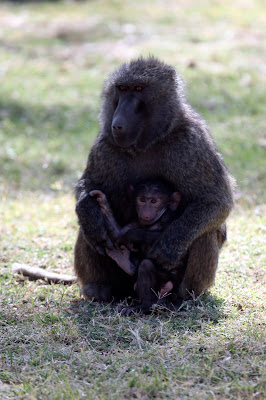March 4th; Nairobi
Jambo! This online journal will cover a recent trip to Kenya, where Dr. Steve Morris and I (Shawn Morris) partnered with a grassroots organization called Wana Duma Project (www.wanaduma.org) in the central region of western Kenya.
After spending four days in Boston visiting family, we are waiting in Amsterdam International Airport for our plane to Nairobi. At the gate, Dr. Steve and I sit next to a Maasai man on his way home from a lecture tour in the United States. He is a beautiful man, adorned in red cloth and holding a simple wooden staff to mark his status as an elite warrior. Although the weather is cold, he wears only thin tire sandals embroidered with colorful beads and no socks.
On the plane, Dr. Steve sparks a conversation with the people in the row ahead of ours; a doctor and an international aid worker bound for East Africa. The doctor is on assignment from Doctor's Without Borders, headed for the Masai -Mara on the far western border of Kenya. The man seated next to her is an Oxfam employee on his way to central Somalia to organize a development project. There is a large group of southern missionaries in the row to my left, on route to a school in the north of Kenya. In fact, my impression is that many, if not all, of the white people bound for Nairobi are on some sort of mission, religious or otherwise.
After a long plane ride we arrive at the Kenya International Airport in Nairobi, the capital city, at 8:00 pm East African Time. As we are approximately half way around the world from our home, Whidbey Island, Washington, the time zones are nearly reversed, and both Dr. Steve and I feel a bit strung out. Suzanne, the director of the Wana Duma Children's Project, and our driver David are waiting for us after we make it through customs and immigration. Suzanne, a tall, slender women with a casual good-humor and relaxed manner welcomes my dad and I to Kenya and leads us out to the arrivals parking lot.
Driving into Nairobi at night is an interesting experience. Advertisements for Western consumer goods are plastered along the roadside, and David tells me about the massive amounts of foreign direct investment (FDI) from Western companies like Proctor and Gamble and Mobile Oil that has been responsible for much of the development surrounding the capital city. We drive past tire factories, skyscrapers, legislative buildings built in the fashion of British architecture, and slum housing on vacant lands within the city. Apparently Nairobi is home to one of the largest slum-dwellings in all of Africa, and though it is dark, I can see that the slum is geographically immense.
We spend our first night at the Cheetah Research Center in a middle-class suburb north of Nairobi known as the Westlund's. The house is simple, with stacks of research papers, wooden furniture, a fireplace, and a small kitchen and bathroom. Early tomorrow morning we head to Gilgil, a town approximately 90 kilometers to the West where Wana Duma Children's Project is located. Once we arrive, Dr. Steve will begin treating patients and we will organize the pharmacy (we brought a duffel bag of supplements along with us).
On the plane, Dr. Steve sparks a conversation with the people in the row ahead of ours; a doctor and an international aid worker bound for East Africa. The doctor is on assignment from Doctor's Without Borders, headed for the Masai -Mara on the far western border of Kenya. The man seated next to her is an Oxfam employee on his way to central Somalia to organize a development project. There is a large group of southern missionaries in the row to my left, on route to a school in the north of Kenya. In fact, my impression is that many, if not all, of the white people bound for Nairobi are on some sort of mission, religious or otherwise.
After a long plane ride we arrive at the Kenya International Airport in Nairobi, the capital city, at 8:00 pm East African Time. As we are approximately half way around the world from our home, Whidbey Island, Washington, the time zones are nearly reversed, and both Dr. Steve and I feel a bit strung out. Suzanne, the director of the Wana Duma Children's Project, and our driver David are waiting for us after we make it through customs and immigration. Suzanne, a tall, slender women with a casual good-humor and relaxed manner welcomes my dad and I to Kenya and leads us out to the arrivals parking lot.
Driving into Nairobi at night is an interesting experience. Advertisements for Western consumer goods are plastered along the roadside, and David tells me about the massive amounts of foreign direct investment (FDI) from Western companies like Proctor and Gamble and Mobile Oil that has been responsible for much of the development surrounding the capital city. We drive past tire factories, skyscrapers, legislative buildings built in the fashion of British architecture, and slum housing on vacant lands within the city. Apparently Nairobi is home to one of the largest slum-dwellings in all of Africa, and though it is dark, I can see that the slum is geographically immense.
We spend our first night at the Cheetah Research Center in a middle-class suburb north of Nairobi known as the Westlund's. The house is simple, with stacks of research papers, wooden furniture, a fireplace, and a small kitchen and bathroom. Early tomorrow morning we head to Gilgil, a town approximately 90 kilometers to the West where Wana Duma Children's Project is located. Once we arrive, Dr. Steve will begin treating patients and we will organize the pharmacy (we brought a duffel bag of supplements along with us).



























